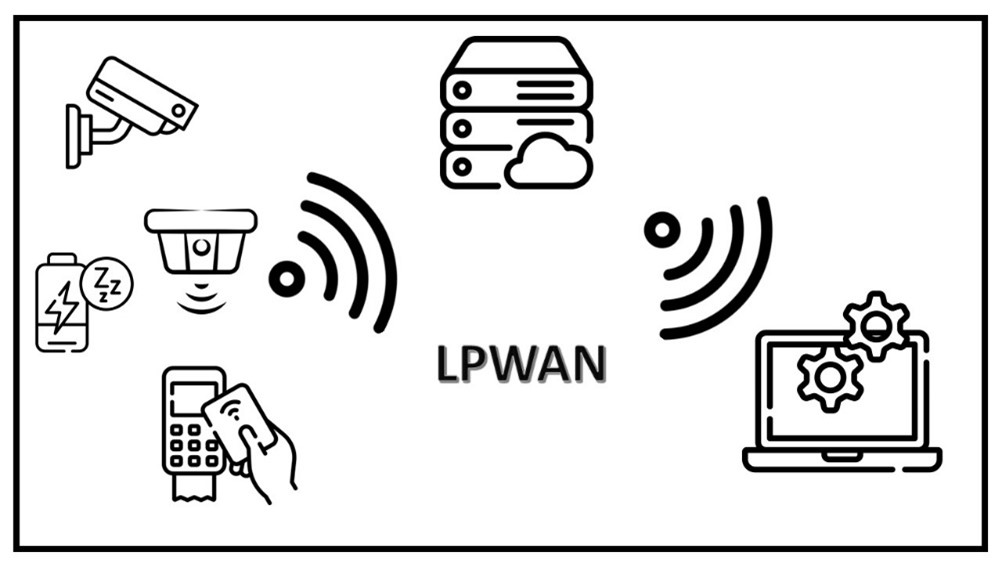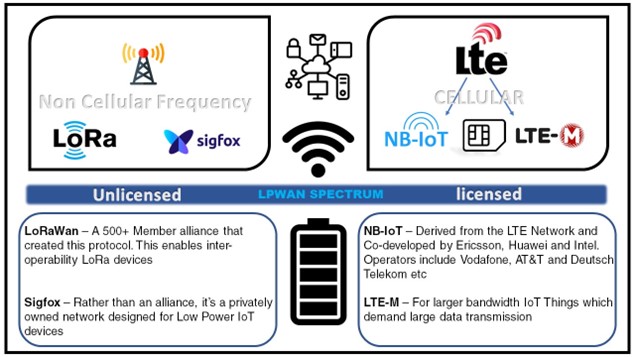Low Power Wide Area (LPWA) is a type of wireless communication technology designed for devices that need to send small amounts of data over long distances. It’s used mainly in the Internet of Things (IoT) for applications like smart meters, environmental sensors, and asset trackers. LPWA technologies are energy-efficient, allowing devices to have long battery life, and they can operate reliably in areas with poor signal coverage. This makes LPWA ideal for connecting devices that need to work for years without needing frequent battery replacements or maintenance.
This technology, certainly in the IoT space is called LPWAN. Low Power Wide Area Network. The beauty of LPWAN its designed to not only reduce power consumption, but also to maximise network coverage and of course reduce overhead costs.

LPWAN are broken down into two groups. Firstly, there are Licensed and Unlicensed LPWAN protocols.

LoRaWAN (Long Range Wide Area Network) and this type of LPWAN that does NOT require cellular connectivity. LoRaWAN uses the lowest and narrowest of bandwidths in the LPWAN family and can only send a limited number of messages per day. LoRaWAN are ideal in settings when a cellular network is not so attenable. Also, It’s not a case of powering up your “Thing” and choose LoRaWAN. As your “Things” must be certified to communicate to a LoRaWAN network and of course your network needs to be configured.
Sigfox is the second protocol of the Unlicensed LPWAN family and is named by the French company Sigfox who owns and developed this technology. These networks are “ultra narrowband” (meaning they use very small frequency bands), and each country only has a single Sigfox network operator.
NB-IoT
The first of the Licensed Bands are NB-IoT which stands for Narrowband Internet of Things. It’s a specially adapted cellular network that can take advantage of unused (but licensed) bands in the radio frequency spectrum. NB-IoT was designed to address some of the past challenges of using cellular connectivity in IoT devices, namely, its power consumption.
NB-IoT devices have the ability to use a Power Saving Mode, where they go to sleep when not in use. This enables NB-IoT devices to operate for years on a single battery charge.
NB-IoT networks uses existing LTE towers and antennas, as this infrastructure is already in place and generally well established. Whereas LoRaWAN and Sigfox networks are still on an ongoing “growth” project, the advantage of NB-IoT enables simplicity as you just connect your “things”. This allows a “ready to go” solution for manufacturers to create Internet-enabled devices.
In terms of range, coverage and deployment cost, there’s no comparison. For mobile applications like asset tracking and supply chain logistics, cellular LPWANs are almost always the most preferred choice.
NB-IoT provides a number of advantages:
• Energy-efficient — The built-in power save mode turns off the NB-IoT module until an event trigger activates it, saving valuable battery life.
• Cost Effective — Low networking and data charges make an NB-IoT network an affordable solution for some applications.
• Reliable communication over long distances—The narrowband IoT architecture is purposefully built to carry little data packets across long distances.
LTE-M
Known as Cat-M1 (Category M1), 4G LTE-M is an extension of 4G LTE technology that uses the same power-saving features as NB-IoT. NB-IoT and LTE-M networks rely on the same infrastructure as 4G LTE.
4G LTE-M networks have a big advantage over NB-IoT networks: It has a far better data rates, which allows your “things” to quickly transmit much larger data packages.
Like NB-IoT networks, LTE-M networks are ideal for long-range mobile applications like asset tracking, but they’re also well-suited for applications that has more data consumption body cams and analytics-related devices. The more data you need to send or receive, the better LTE-M is in comparison to NB-IoT. It can transmit and download faster, which means your device stays online for less time.
1. Smart Cities: Pioneering Urban Efficiency
Smart cities are the epitome of urban innovation, and NB-IoT is playing a central role in their development. From smart street lighting that adjusts based on usage patterns to intelligent waste management systems that optimise collection routes, NB-IoT is making cities more efficient, sustainable, and liveable.
2. Precision Agriculture: Cultivating the Future
In agriculture, every drop of water counts, and every degree of temperature matters. NB-IoT sensors deployed across farmlands provide real-time data on soil moisture, temperature, and humidity, enabling farmers to optimise irrigation, monitor crop health, and maximise yields. This precision agriculture approach is revolutionising farming practices, making them more sustainable and productive.
3. Industrial Automation: Driving Efficiency and Safety
In the realm of industrial automation, NB-IoT is a game-changer. By connecting machinery, equipment, and assets, NB-IoT enables predictive maintenance, remote monitoring, and process optimisation. This not only boosts efficiency and productivity but also enhances workplace safety by detecting and addressing potential hazards in real time.
4. Healthcare: Enhancing Patient Care
The healthcare sector is undergoing a digital transformation, and NB-IoT is at the forefront of this revolution. From remote patient monitoring devices that track vital signs to smart pill dispensers that ensure medication adherence, NB-IoT is empowering patients and caregivers alike. With NB-IoT, healthcare becomes more personalised, accessible, and efficient.
5. Environmental Monitoring: Safeguarding Our Planet
Climate change and environmental degradation are global challenges that require immediate action. NB-IoT sensors deployed in urban areas, forests, and oceans provide valuable data on air quality, water levels, and biodiversity. This information enables policymakers, scientists, and conservationists to make informed decisions and implement effective strategies for environmental protection and conservation.
Siretta Solutions
At Siretta, we offer a comprehensive range of products designed to leverage LTE Cat M and NB-IoT networks. Our solutions include modems, antennas, and signal analysers tailored to meet the needs of diverse IoT applications.
Modems
Our ZETA and SL500 solutions provide reliable and low-power connectivity options for LTE Cat M and NB-IoT networks. These modems support a wide range of applications, from remote monitoring to automated data collection, and come with features such as serial communication interfaces and compatibility with Siretta’s cloud-based management portal SirettaLINK.
Cellular Network Analysers
The SNYPER IoT Graphyte includes high-performance network signal analysers that are essential for surveying and logging LTE Cat M, NB-IoT, and 2G/3G networks. This analyser helps in determining the optimal placement for antennas and selecting the best mobile network operator for your specific location.
Antennas
Our range of versatile antennas is designed to provide robust and reliable connectivity across various frequency bands, ensuring that your IoT devices remain connected even in challenging conditions. These antennas are critical for applications requiring consistent and strong signal reception.
LTE Cat M and NB-IoT are pivotal in the advancement of IoT connectivity, offering distinct advantages that cater to various application needs. Whether you require higher data rates and mobility or deep coverage and power efficiency, these technologies have you covered. At Siretta, our diverse range of modems, signal analysers, and antennas are designed to maximise the potential of these networks, providing robust and reliable solutions for your IoT deployments.
Explore our products and discover how Siretta can support your IoT applications with unique connectivity solutions.


